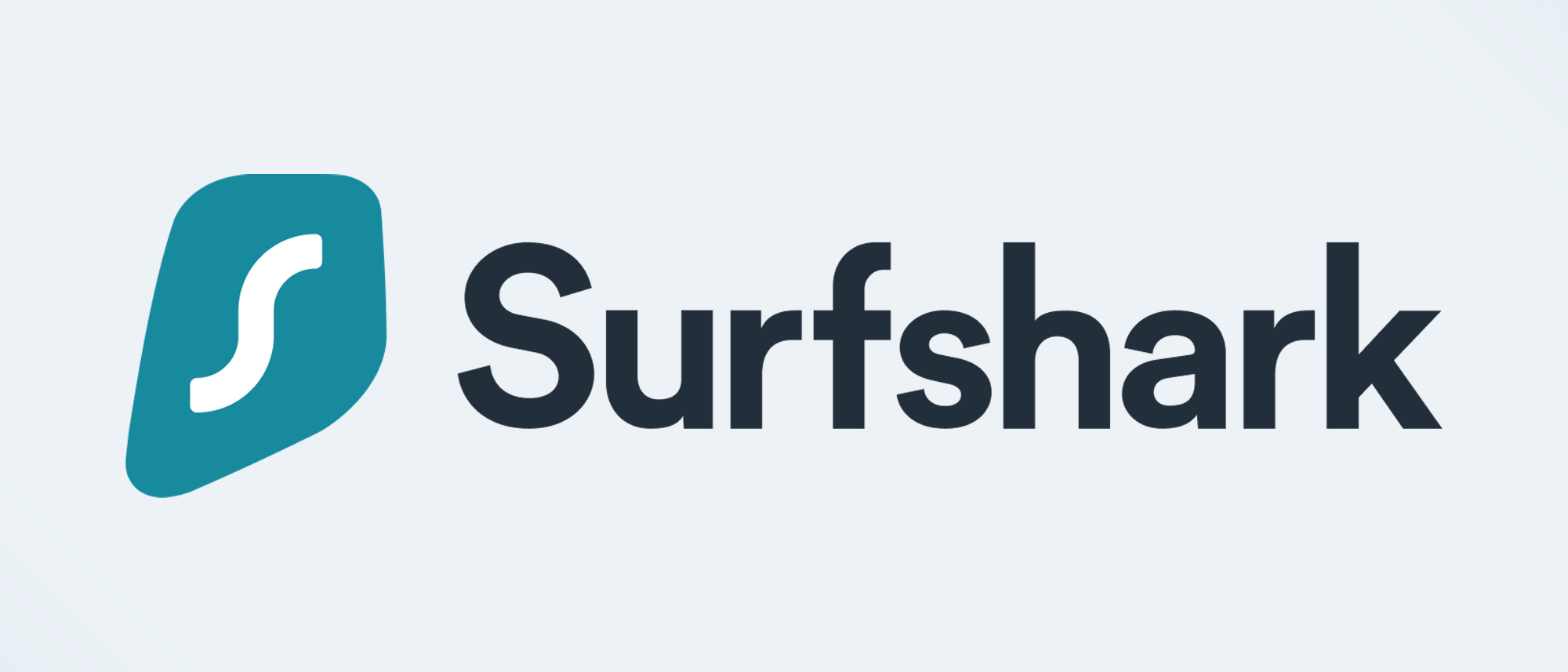Tom's Guide Verdict
Surfshark’s low overhead, fast accurate scanning and unlimited VPN use add up to very good protection at a great price, but its malware coverage is only available for five users and the package lacks many security creature comforts, like file encryption and shredding as well as webcam protection.
Pros
- +
Very good malware protection
- +
Includes unlimited VPN
- +
Simple interface
- +
Inexpensive
- +
Fast full scans
Cons
- -
Only available in five packs
- -
Lacks hardened browser, webcam protection, file encryption and shredding
- -
Heavy scanning performance penalty
Why you can trust Tom's Guide
Malware protection: Very good
System impact, background: Low
System impact, scans: High
Windows compatibility: 7 through 11
Anti-theft: No
Backup software: No
File encryption: No
File shredder: No
Firewall: No
Game mode: No
Hardened/secure browser: No
Parental controls: No
Password manager: No
Performance scanner: No
Ransomware rollback: No
System optimizer: No
Webcam protection: No
Virtual keyboard: No
VPN: Yes
Wi-Fi scanner: No
Support options: 24/7 email, chat
A newcomer to the world of security software, Surfshark attempts to defend systems with a simple, no-nonsense suite that sticks to the basics. As others pile on the features, Surfshark One is understated in its approach with an emphasis on providing easy-to-use essential security. Sure, it lacks many of the things we expect – like webcam protection and file shredding and encryption – but it's more than compensated for by Surfshark’s focused approach, simple interface and fast scanning. Its scanning is accurate but the program tends to put a large burden on the system.
If that were all that Surfshark did, it would be a good deal at $29 a year for the first year. Rather than an expensive add-on, Surfshark One includes unlimited access to its VPN, a no-tracking search window and identity breach alerts. Surfshark One may be inexpensive but it is only available in five-packs. Still, with a price tag in line with competitor’s basic plans, Surfshark One delivers a lot more. Our Surfshark One review will help you decide if this is the best antivirus software for you and whether or not it delivers the right protection for your systems.
Surfshark One review: Costs and what’s covered
While competitors have upwards of five plans, the appropriately named Surfshark One only has a single offering. The package combines malware protection for five with an unlimited VPN for $13.87 a month with no long-term commitments. This drops to $29 a year for the first year and then increases to $92 annually upon renewal (and you can also get the odd saving with our Surfshark VPN promo codes).
There’s no free or trial version to test out but the company does have a 30-day money-back guarantee.
While the Surfshark antivirus program works with Windows 10 and 11, the VPN and other portions of Surfshark One work with Windows 7-11. In addition to MacOS 10.15 or newer software and Ubuntu and Debian Linux systems, Surfshark One is compatible with tablets and phones using Android version 5 or iOS 10.3.3 or newer. It covers Chrome, FireFox or Edge and smart TVs that use Fire TV or Android TV software.
Surfshark One review: Antivirus protection
Surfshark One protects with three overlapping levels of malware defense. It starts with traditional scanning with an efficient engine and a deep database of threats provided by Avira. This is augmented with behavioral monitoring for early signs of an infection or files that are being renamed, moved or encrypted.
Finally, the software sends any potentially dangerous code to an online lab for analysis. On the downside, there’s no way to opt out of having the company copy items from your system that might be dangerous. For some this will be a non-starter. The company sends out threat updates several times a day, sometimes as often as every 15 or 20 minutes.
In addition to stopping Potentially Unwanted Apps (PUAs) from being installed, Surfshark One can protect against botnets and fileless malware. On the other hand, it treats ransomware like other threats with no way to rollback change.
Other than turning real-time protection on or off, there are few areas for customization. Surfshark lacks a slider to increase or decrease the level of protection or an automatic method of altering the program’s security stance. Plus, the program doesn’t have a gaming or movie mode to reduce intrusions.
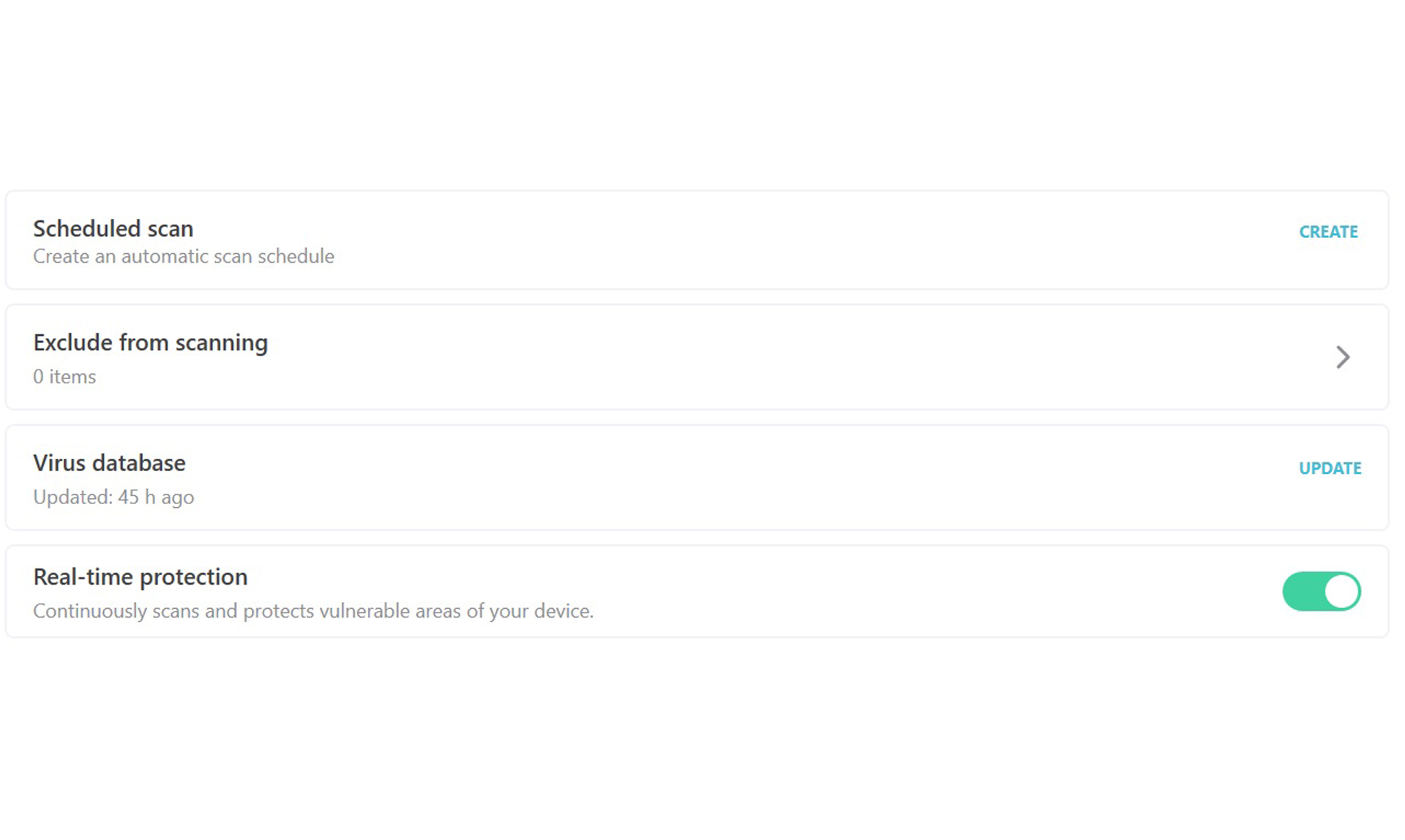
Within Windows explorer, users can right-click on any file or folder to scan it. I was able to drag a folder or file to a scanning rectangle in Surfshark’s antivirus interface for assessment though.
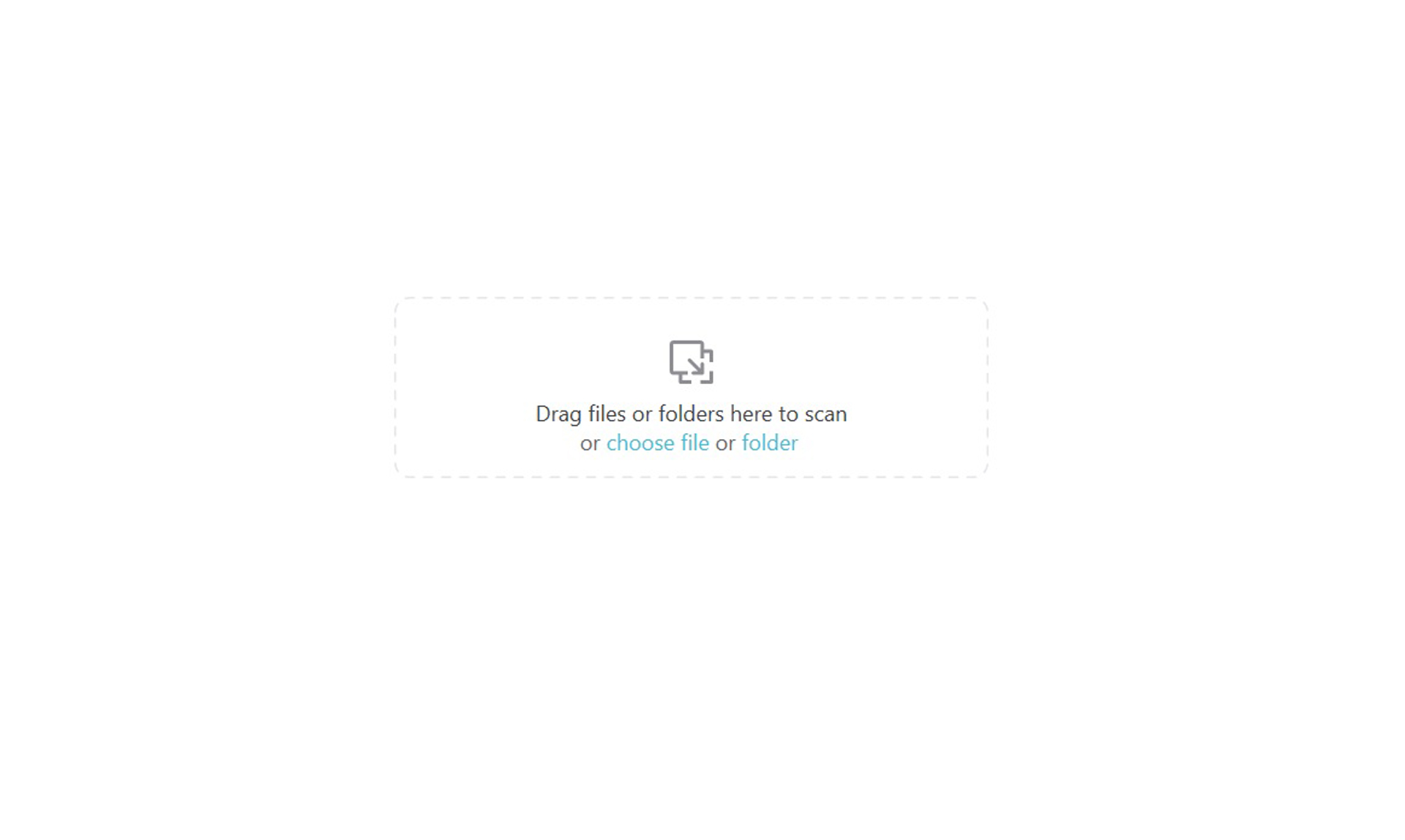
You’re out of luck if you have a system bogged down with malware as Surfshark lacks recovery media for starting and cleaning a system.
Surfshark One review: Antivirus performance
At Tom’s Guide, we report on the results from three independent malware testing organizations: AV-Test, AV Comparatives and SE Labs. As Surfshark uses Avira’s antivirus technology, we will use those test results along with the most recent Virus Bulletin survey, the only direct testing for this product.
In the Virus Bulletin’s May 2022 report, Surfshark achieved a 100 percent success rate for common and prevalent malware. This dropped to 99.85 percent for the more obscure threats category. To its credit, Surfshark had zero false positives. Avast matched that accuracy level but was slightly off with a score of 99.8 percent on the more obscure attacks.
Based on the results for Avira’s scanning engine, AV-Test’s March-April 2022 survey shows a 100 percent success rate in zero-day malware and widespread malware. Others, like Kaspersky and Trend Micro, matched this thoroughness and all three had zero false positives. By contrast, Bitdefender missed a few new threats in March with a 98.6 percent score and had three false positives.
The results of the Avira technology used by Surfshark on the AV Comparatives’ analysis for February through May were just as impressive with a 100 percent success rate. That matches the protection provided by Norton LifeLock and Trend Micro. While the Avira-Surfshark combination had seven false positives, it’s not so bad compared to 50 and 42 misidentifications of safe code by Norton and Trend Micro. Only ESET had no false positives but at the cost of a 99 percent efficacy.
In the fourth quarter of 2021, SE Labs testing showed that Avira-Surfshark combo had an overall score of 97 percent for preventing serious attacks. The software also had no false positives during the tests. That said, Norton LifeLock and Kaspersky outshined it with a 100 percent effectiveness score and no false positives.
Surfshark One review: Security and privacy features
While Surfshark provides very good protection, it can’t match the array of features the best internet security suites provide. This is by design with the company seeking a simple and powerful defense against malware. Still, the program does without a password manager, parental controls, a firewall, file encryption and shredding. Surfshark is working on adding webcam protection though.
In addition to its platform-based malware protection, Surfshark can defend at the browser level with extensions for Chrome, FireFox and Edge that can filter out malware and block ads.
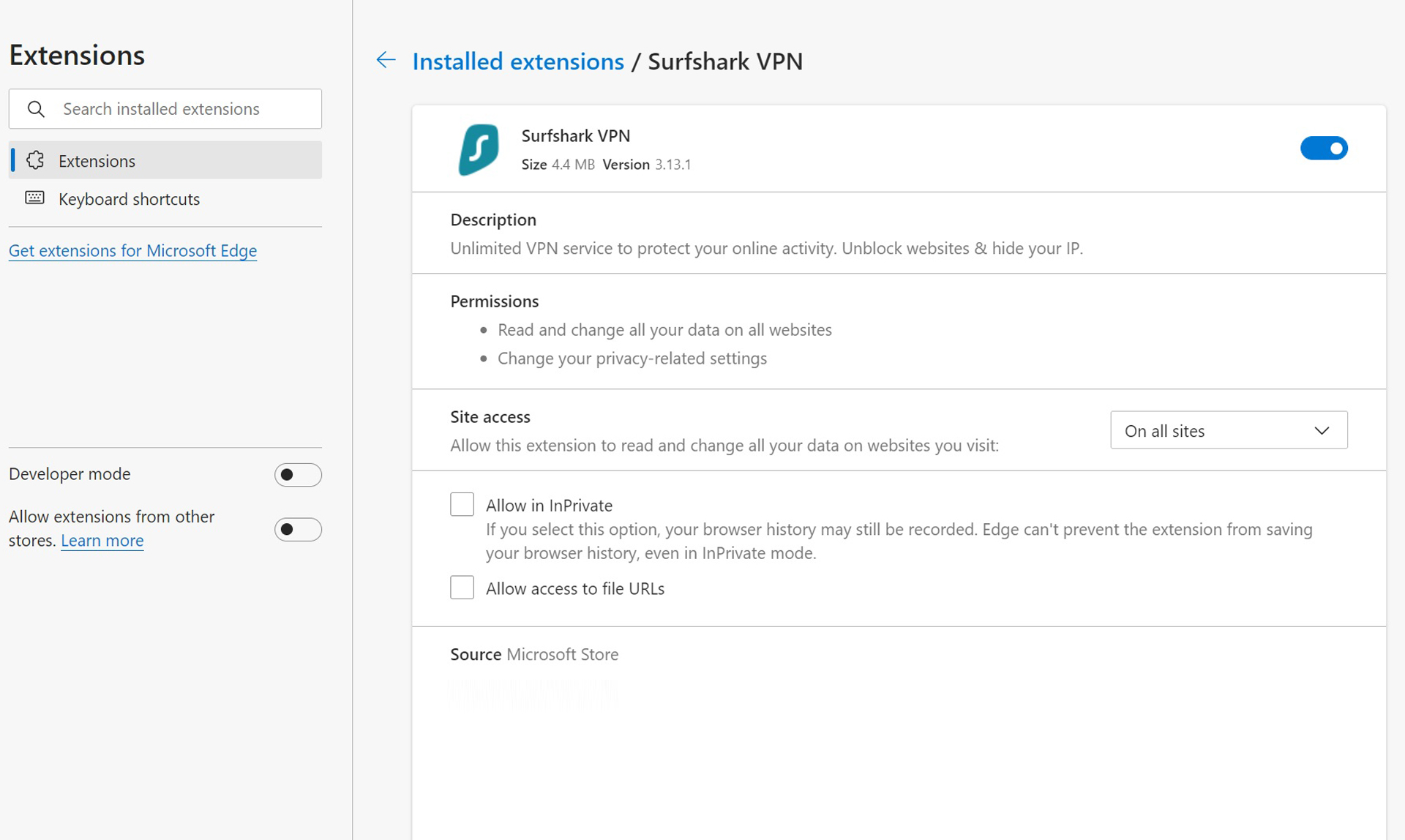
In addition to its platform-based malware protection, Surfshark can defend at the browser level with extensions for Chrome, FireFox and Edge that can filter out malware and block ads.
Surfshark’s Search is a safer way to surf the web without being tracked or leaving cookies behind. The company promises not to sell your browsing data or use it for marketing purposes.
The Alert app scans the internet and dark web for instances of your email address, credit card information and social security number, potentially providing an early warning of identity theft. After a quick scan, the program found seven potential problems for my identity.
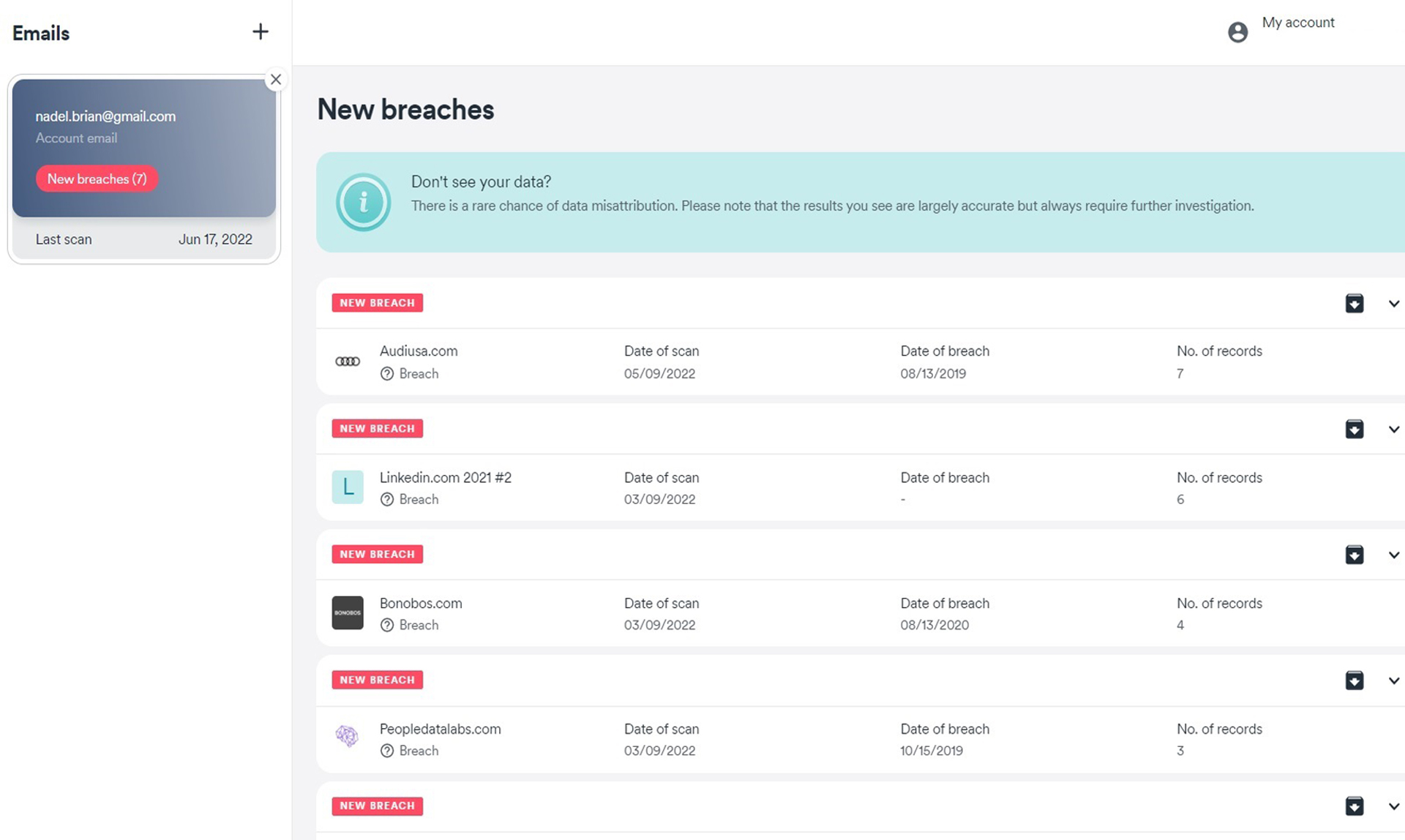
There’s no hardened browser for banking and online shopping but Surfshark One includes an unlimited VPN. Surfshark’s VPN is equally good for securing communications as it is for streaming geo-blocked content with connection points in 100 countries.
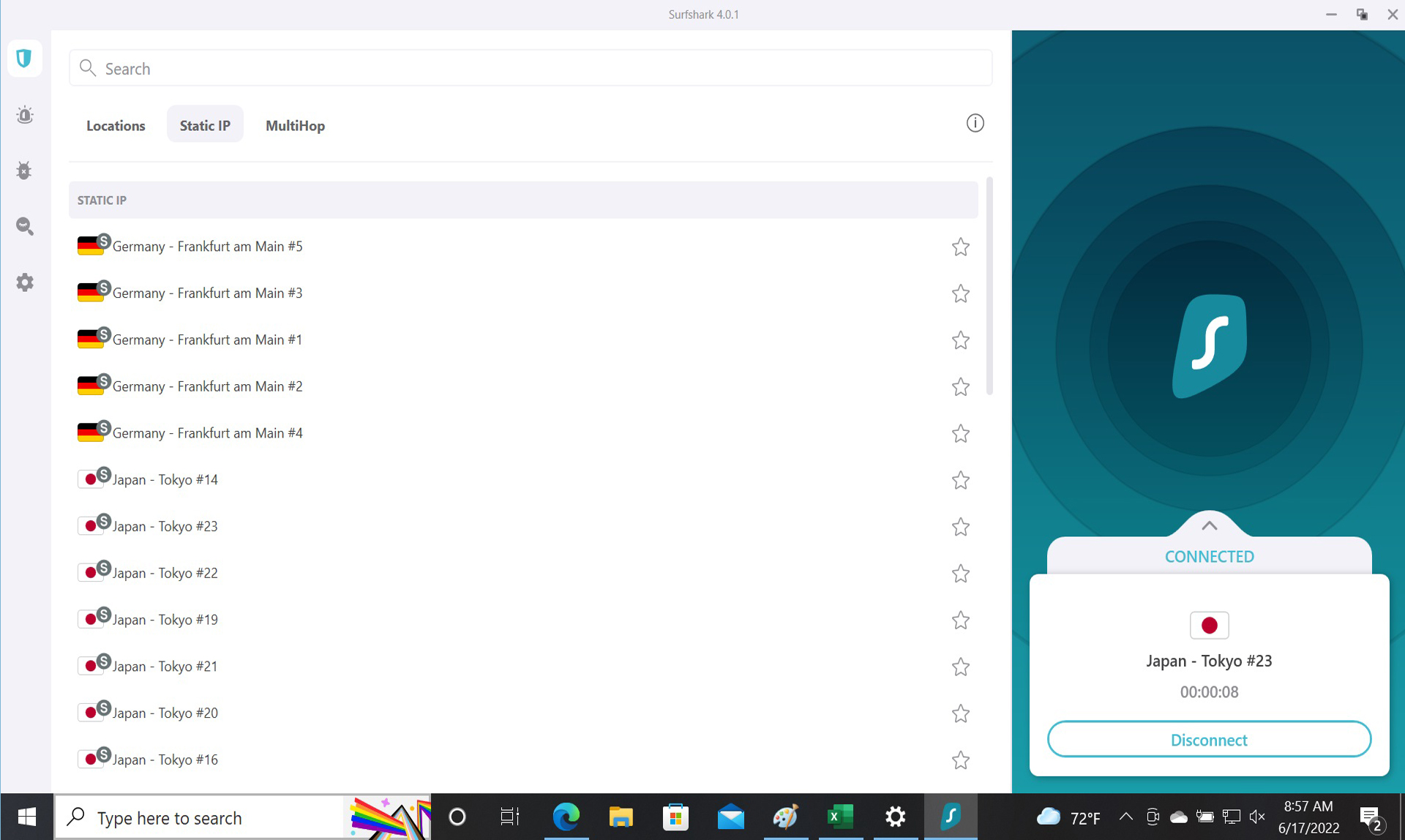
In addition to countries ranging from Azerbaijan to Vietnam, there are 25 U.S. locations. The Surfshark VPN took just 3.9 seconds to connect to a New York City server.
Surfshark One review: Performance and system impact
To measure the impact Surfshark had on a computer’s performance, we used our custom benchmark test, which clocks how long a PC takes to match 20,000 names and addresses on an Excel spreadsheet. We used a Lenovo ThinkPad T470 testbed with the latest Windows 10 updates, a 2.5GHz Core i5-7200U processor, 8GB of RAM and 256GB of solid-state storage with 61.2GB of files.
Prior to installing Surfshark, the ThinkPad T470 recorded a benchmark score of 10.2 seconds. This baseline reading rose to 11.0 seconds after Surfshark was installed, showing a 7.8 percent decline in performance potential. This matches that of ESET but was between Bitdefender’s no impact and McAfee’s 28 percent performance drop.
While running a Full Scan, the benchmark score rose to 16.8 seconds, a potential performance decline of 52 percent. This was the largest drop and doesn’t compare well to ESET’s 11 percent drop. A Quick Scan lowered the system’s performance potential by 3.6 percent to a benchmark score of 11.4 seconds.
The program took 10:47 to run through a full scan of 557,302 files. Others like Bitdefender Total Security examined nearly 1.5 million items in a full scan but took longer. While under 11 minutes is fast compared to McAfee’s nearly three-hour first scan, others scanned faster on subsequent runs as they recognized what to examine and what to ignore. By contrast, Surfshark looked at the same files for roughly the same amount of time.
The program’s Quick Scan took two seconds to run but it only looked at the eight files most likely to be seriously infected. Others scanned up to 12,000 potential targets but lowered performance by as much as 30 percent compared to Surfshark’s 3.6 percent decline.
Surfshark One review: Interface
Surfshark has one of the simplest and most straight-forward interfaces but lacks customization options. A bonus is that Surfshark can run full screen or as a smaller window so you can concentrate on its results and remediation.
There’s no overall dashboard with a color-coded icon to tell you everything is OK. Instead, along the left side are the program’s main elements, each with their own screen. The VPN is at the top and I was able to pick the location to connect, the fastest connection speed or the nearest connection point. In the lower right are recently used VPN servers for quick access.
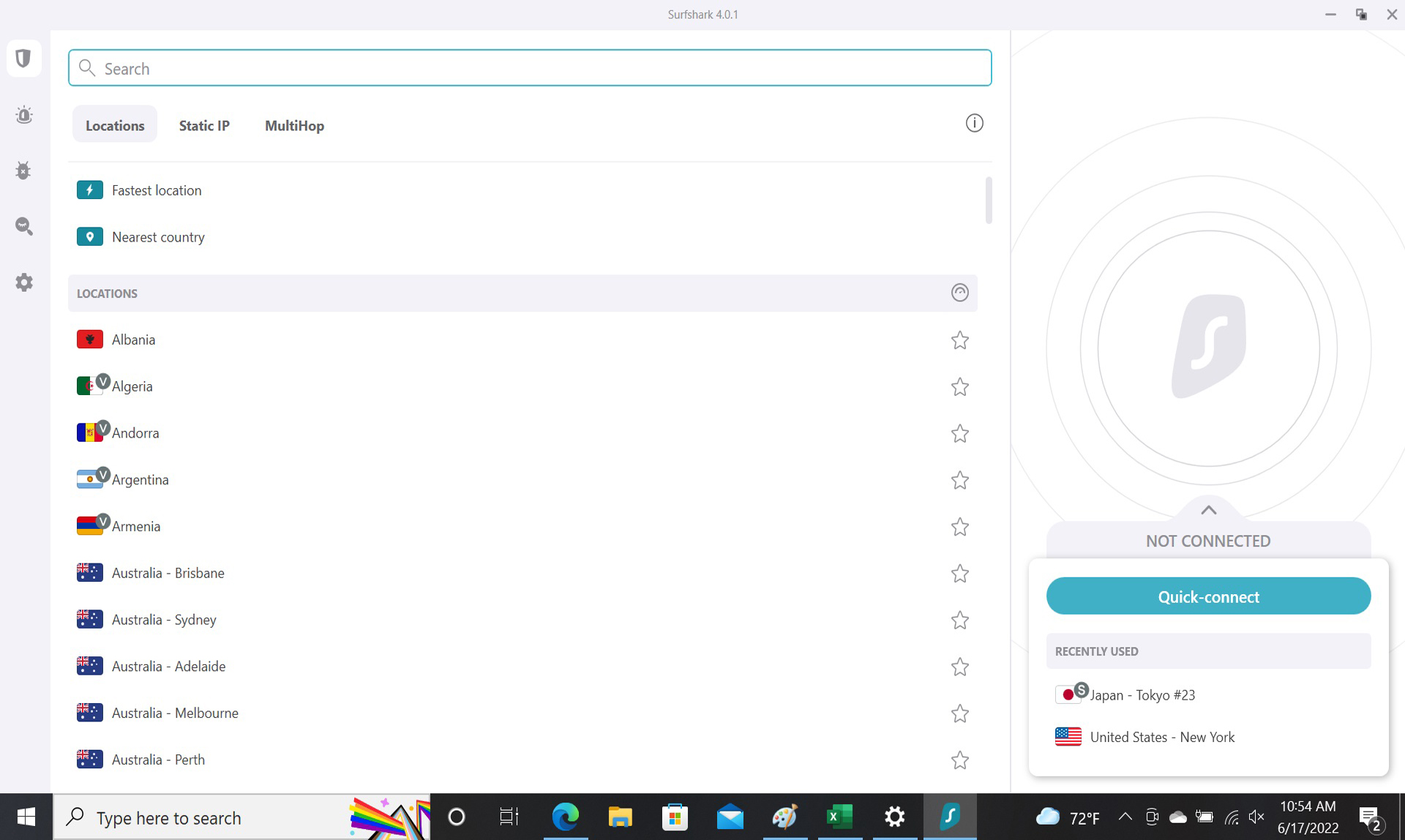
In the Alert section, I saw the results of SurfScan monitoring my email address, ID and credit cards. It shows recent breaches on a separate page while the Settings page lets you remove your personal data from Surfshark’s site.
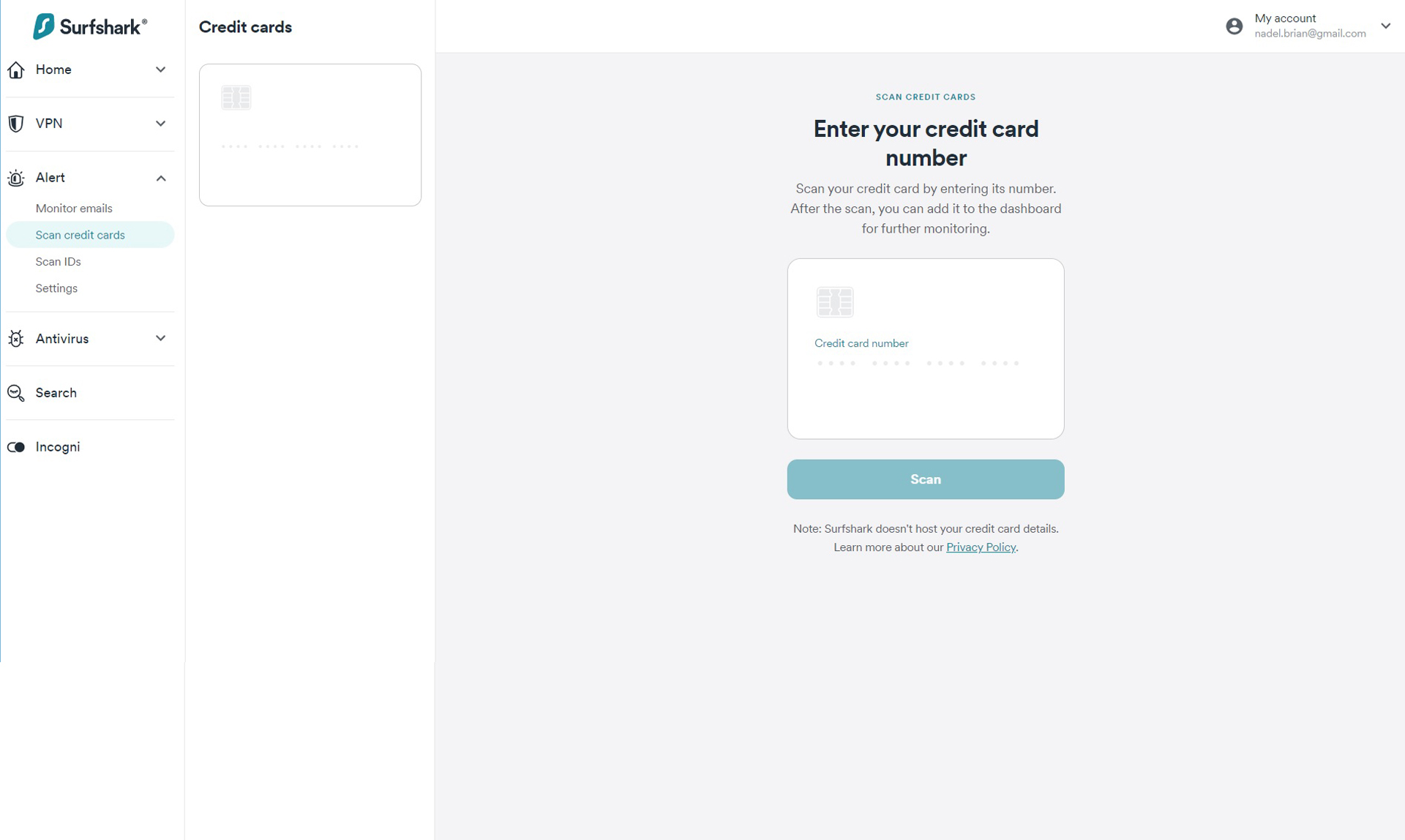
Surfshark has one of the simplest and most straight-forward interfaces but lacks customization options. A bonus is that Surfshark can run full screen or as a smaller window so you can concentrate on its results and remediation.
Meanwhile, the Antivirus’ main screen has a small icon in the upper right with a checkmark when things are safe.
Besides a place to schedule scans or whitelist items, the interface shows when the threat database was last updated and can be manually refreshed. There’s a button for turning real-time scanning on or off and a place to drag files or folders for scanning.
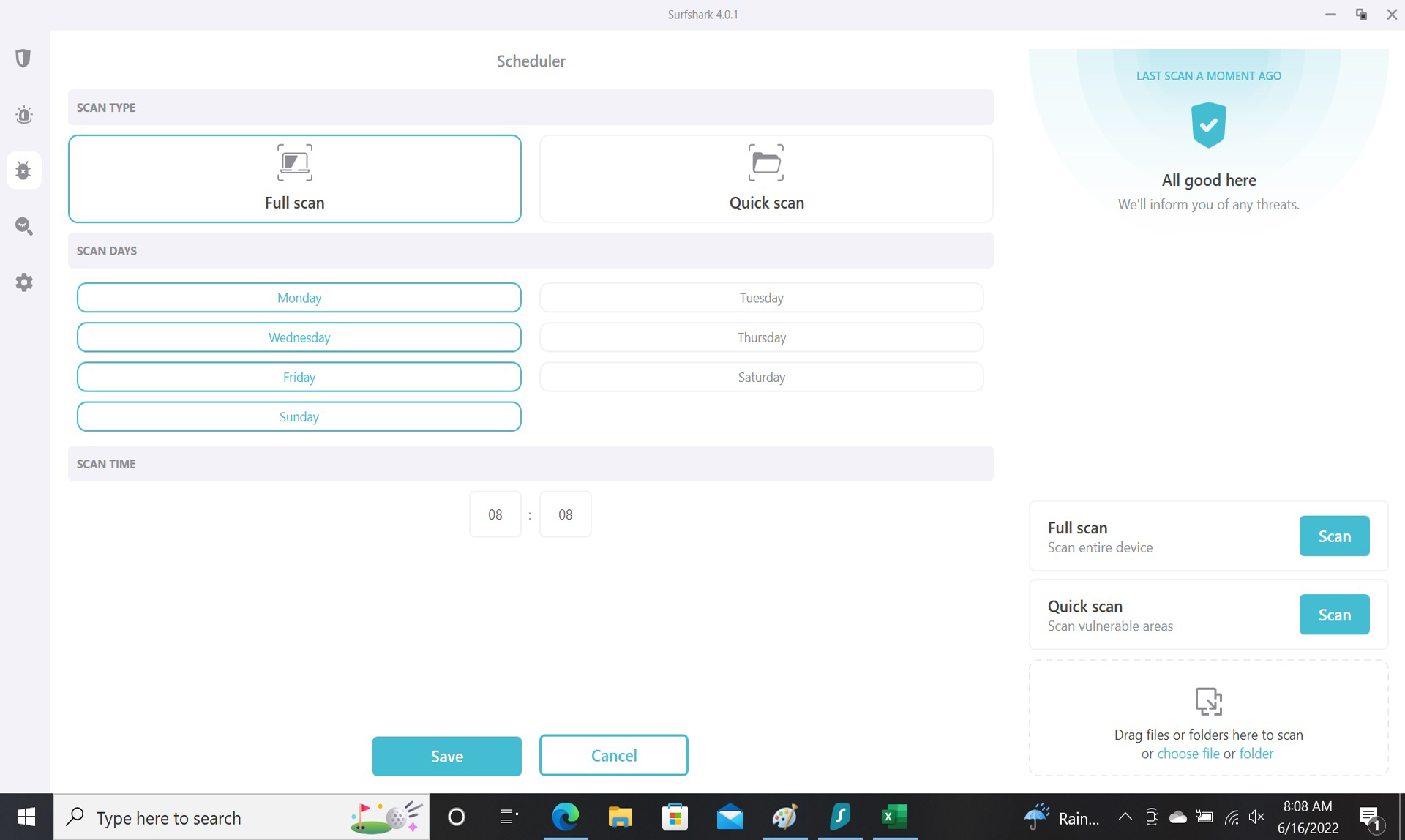
Search is the simplest of Surfshark’s five components with a place to type a search term. The app promises to neither track your system nor share your search terms with others.
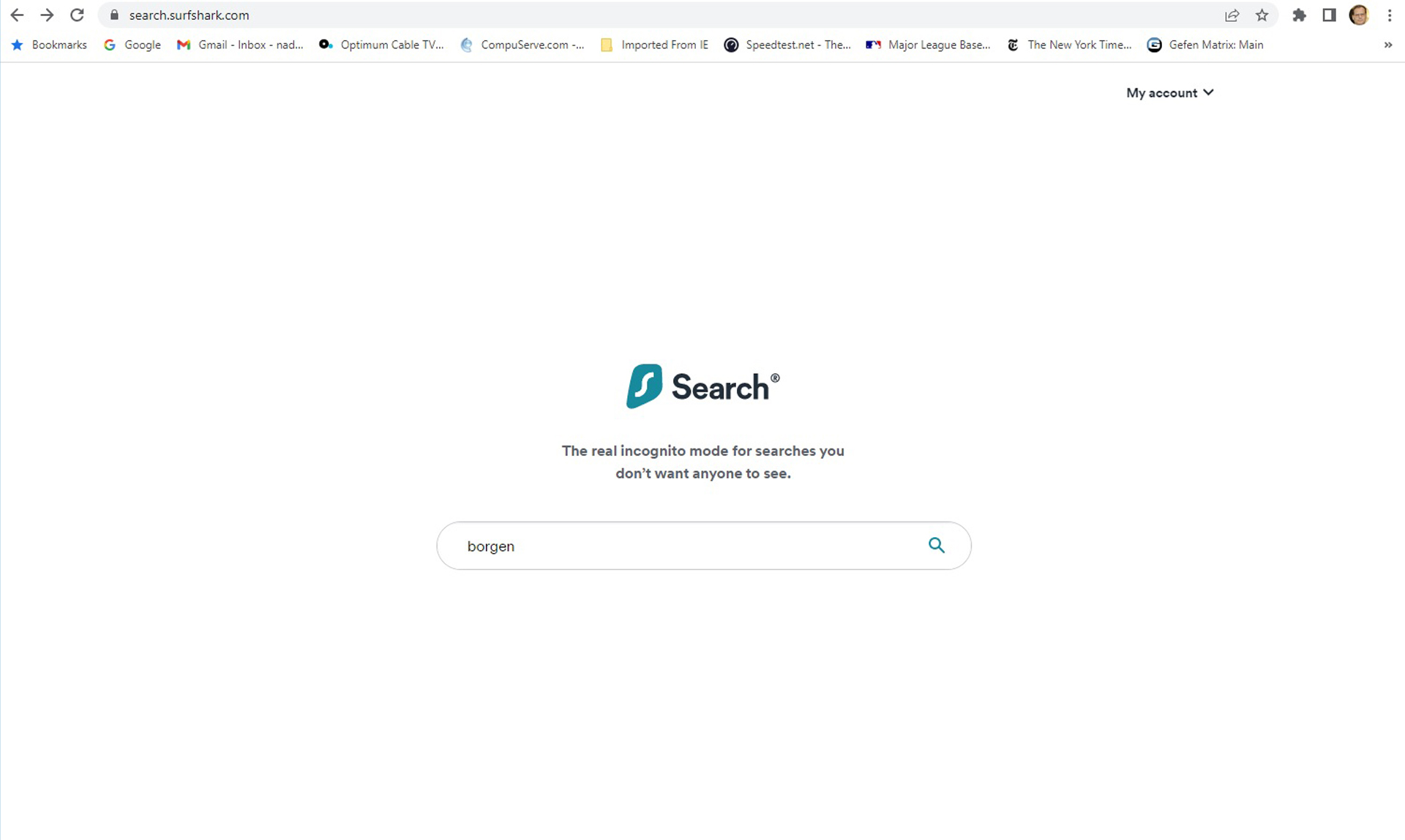
Meanwhile, the Settings category offers just a few customization options. In addition to VPN details like the kill switch and what protocol to use, there are settings for the app that include language and dark mode.
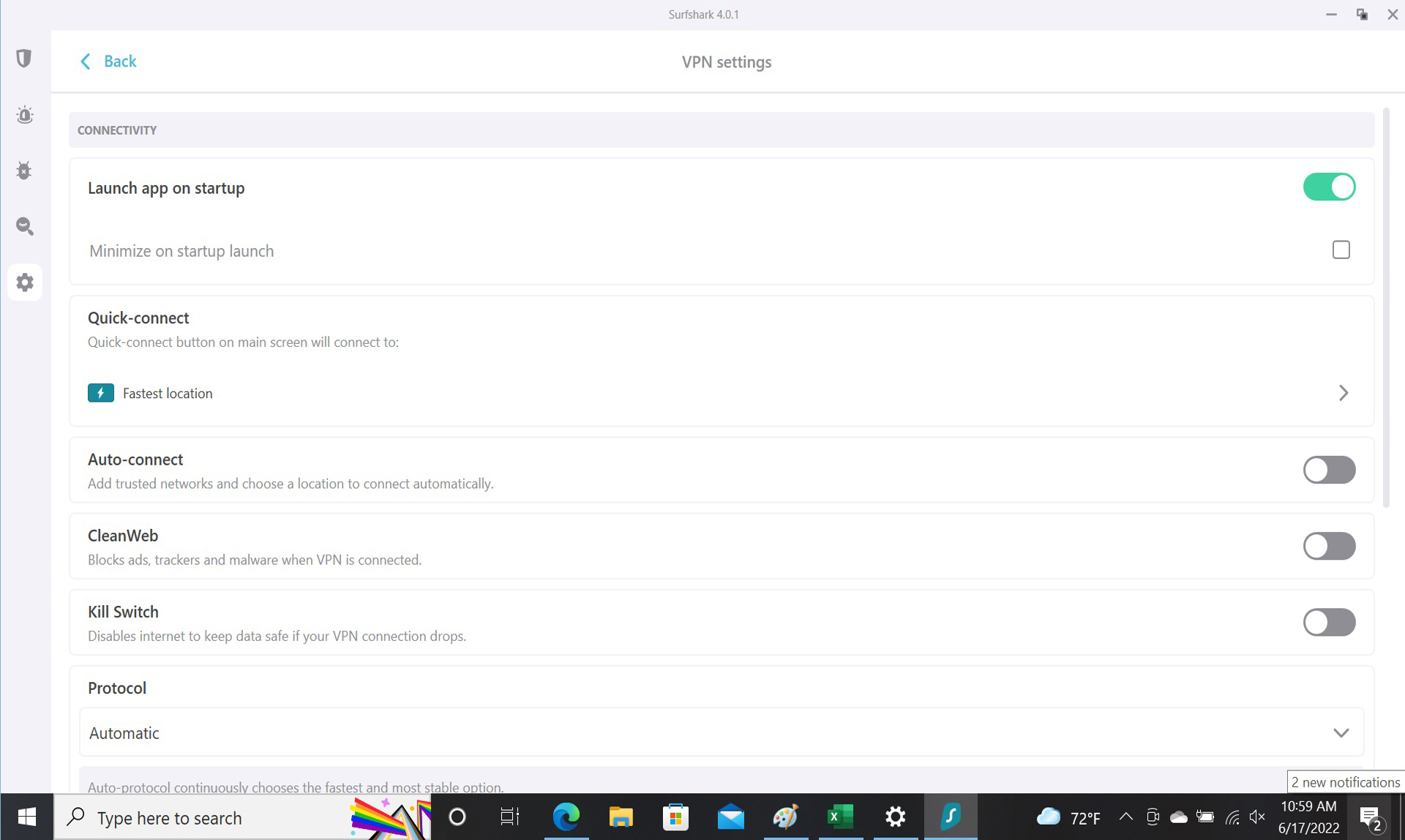
At the bottom of the Settings page is Help with lots of tips and tricks for getting the most out of Surfshark. Unfortunately, there’s no direct link to email the company’s support staff.
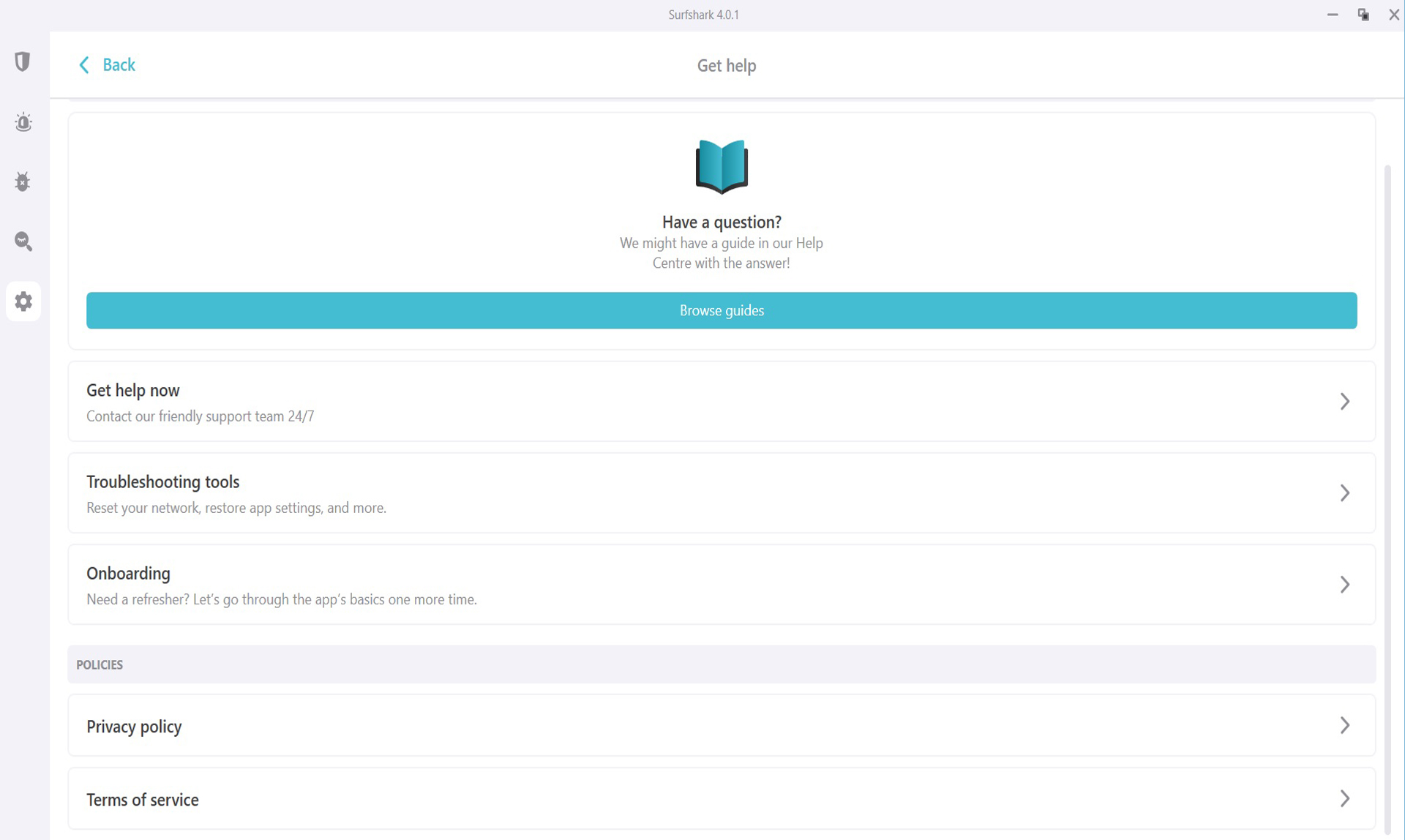
The Task Tray icon leads to a Quick Connect button for the VPN. However, I was able to add shortcuts for everything from scanning the system to using the VPN’s Kill Switch.
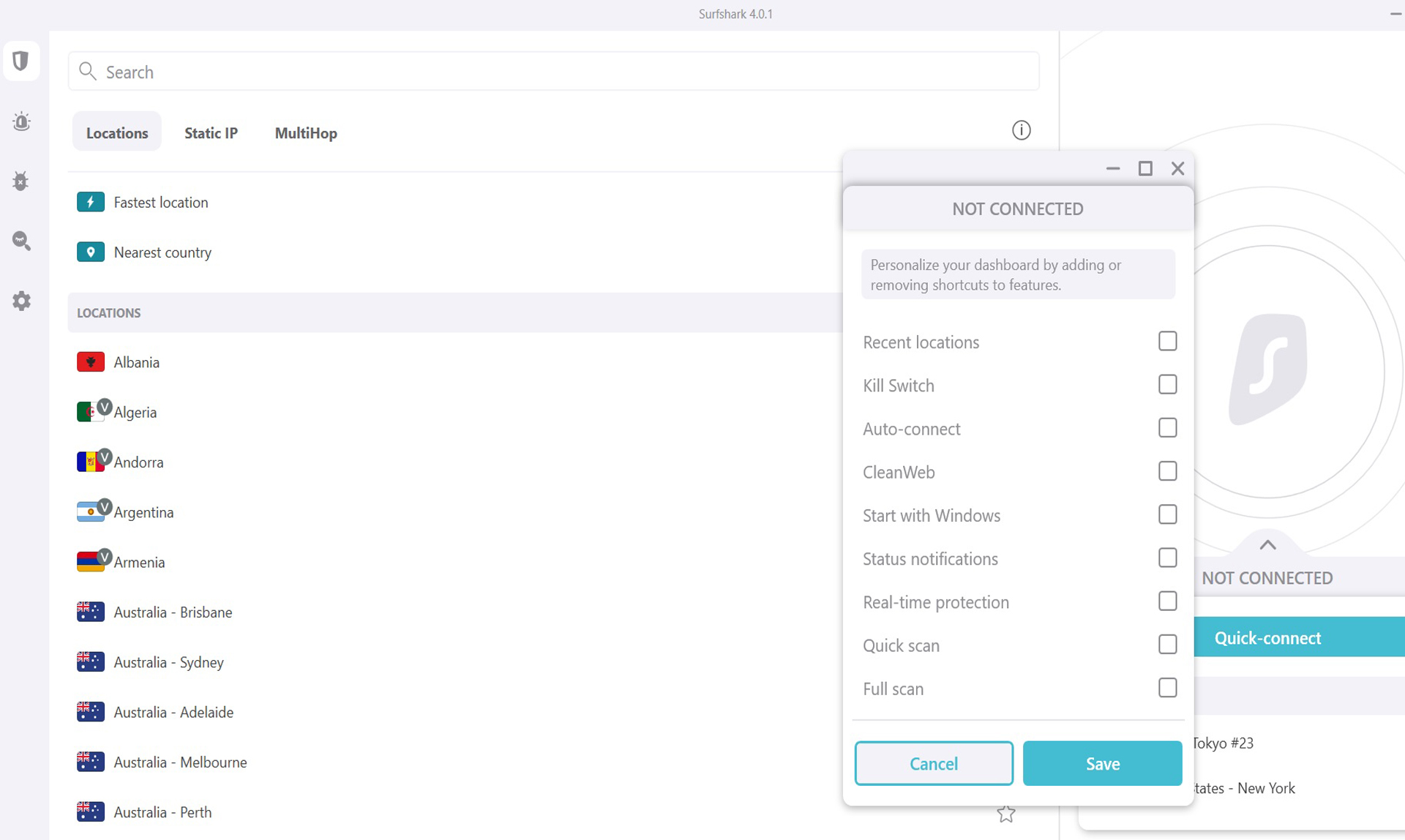
Surfshark One’s online portal does more than provide software downloads. I could see what systems were protected and protect new ones.
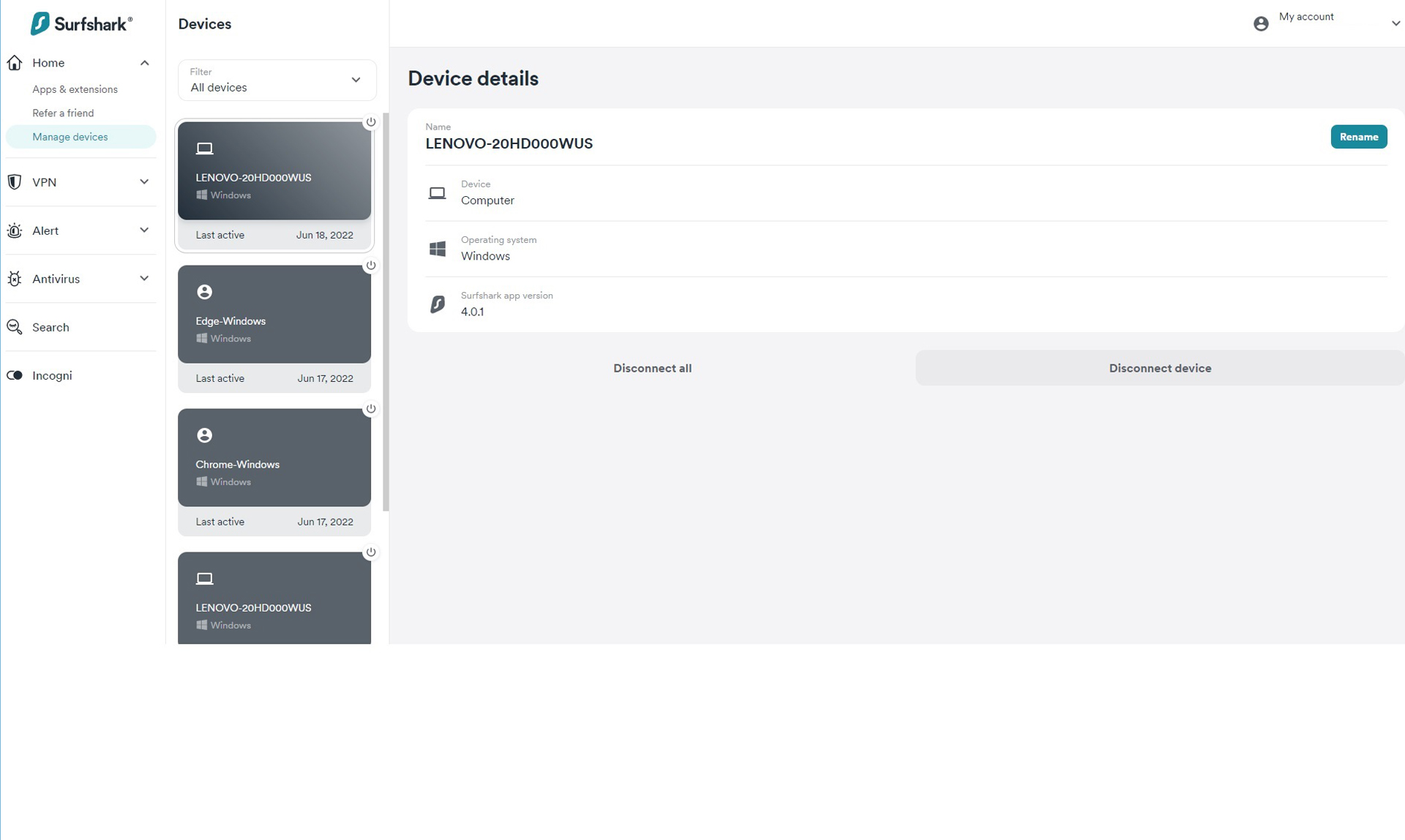
There’s also a 20 percent discount available for Incogni to keep your infromation out of the hands of data brokers.
Surfshark One review: Installation and support
Getting Surfshark One loaded and running was easy but involved a two-step process. It started with downloading the 52.4MB setup file from the company’s website and running it.
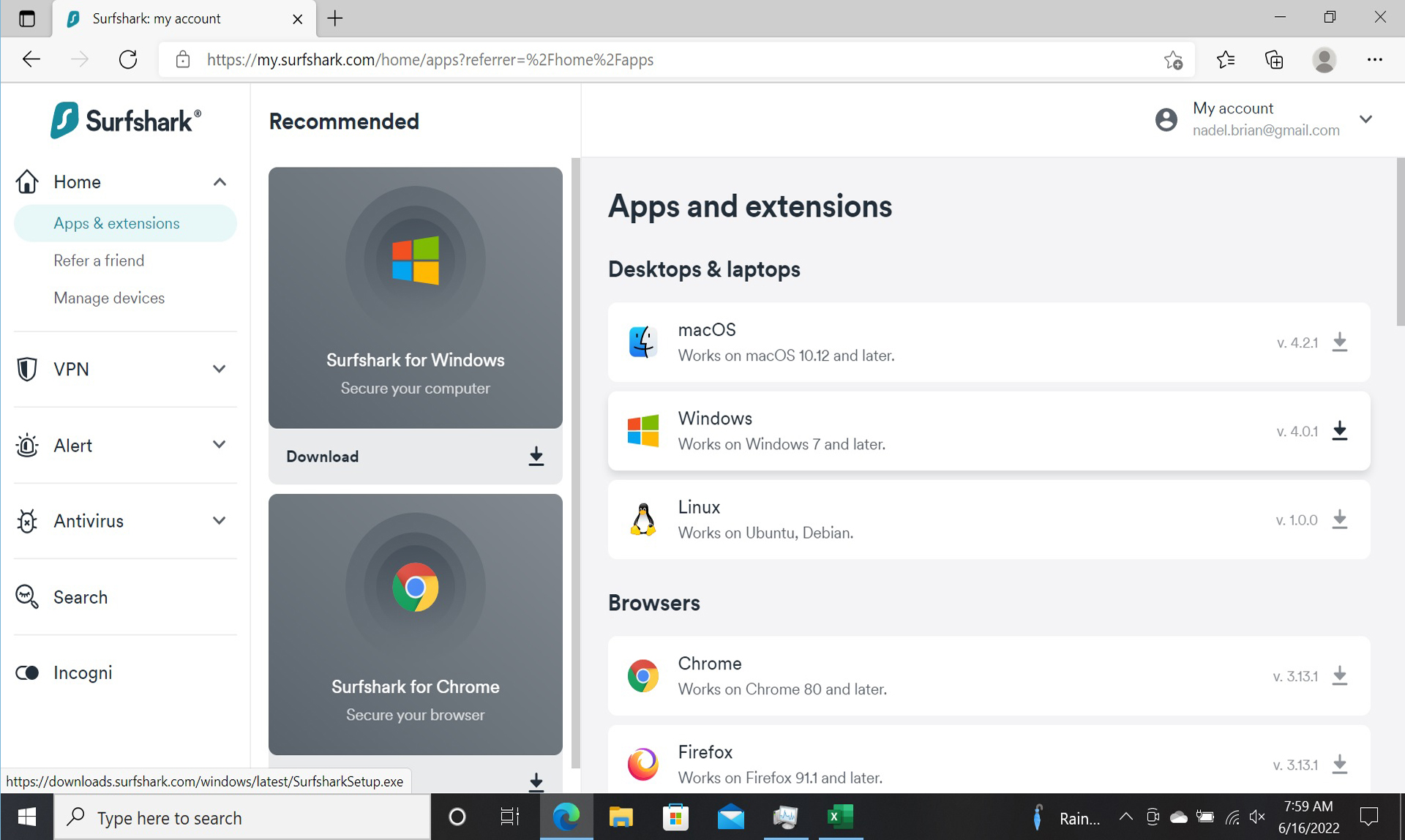
This was followed by signing up for an online account and paying for the subscription. You can pay with a credit card, PayPal, Google Pay, Apple Pay or with cryptocurrency.
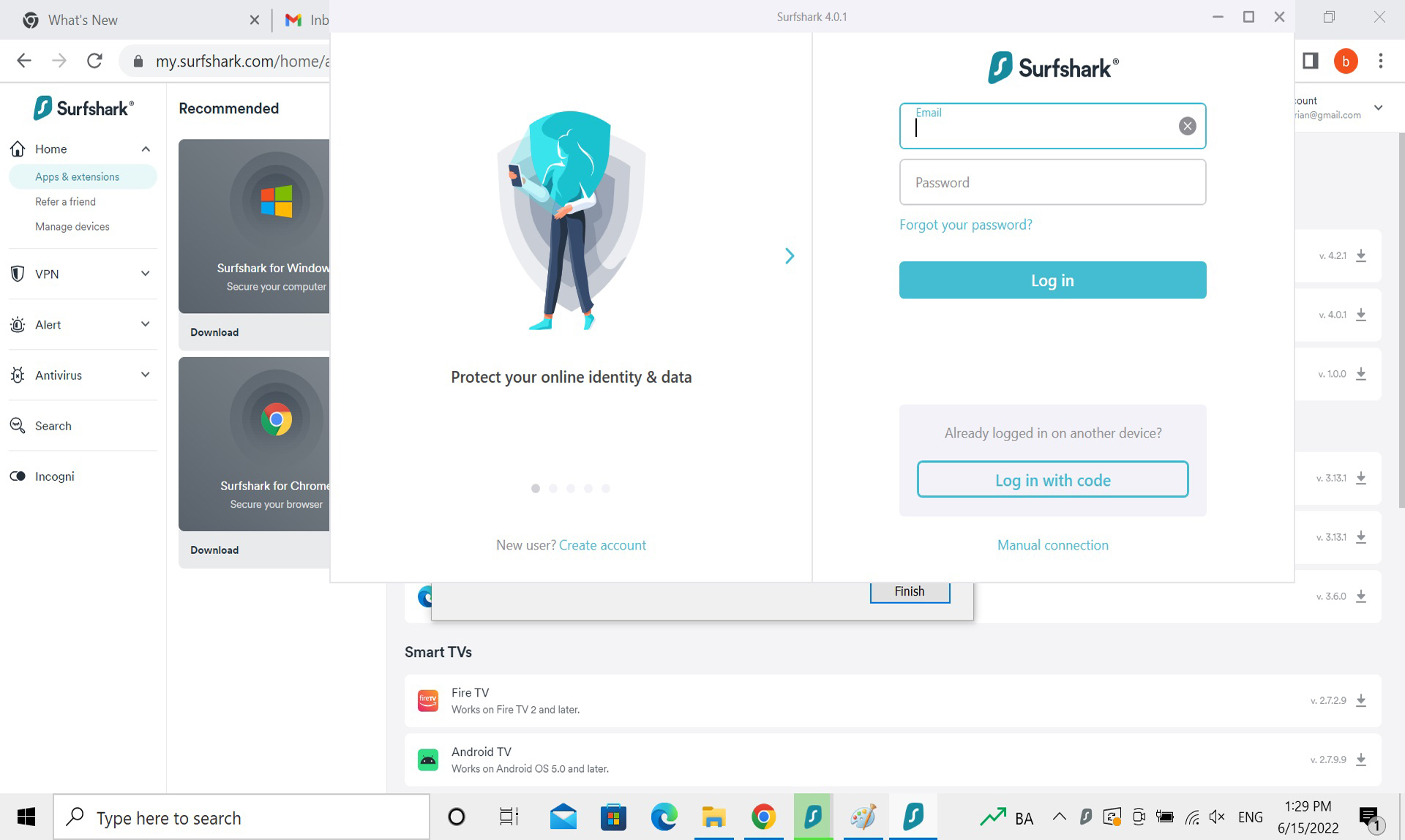
Unfortunately, this only covers the VPN installation. Next step, download the 240MB antivirus program. When done, the software offered a Quick Scan and a way to schedule scans. All told, it took 7 minutes and 45 seconds to protect my system.
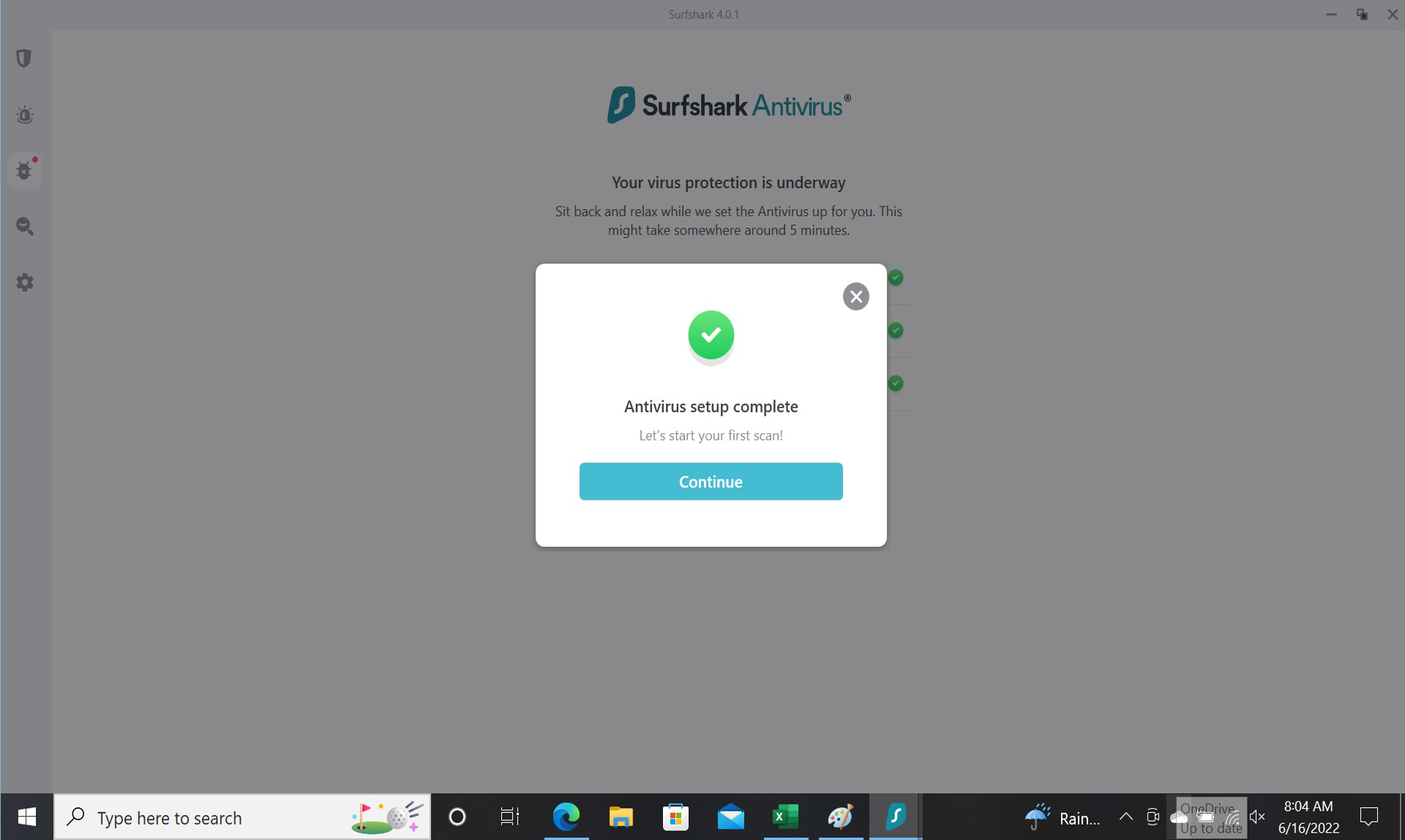
Surfshark’s technical support desk is staffed 24/7 and offers online chat and email support but no phone support.
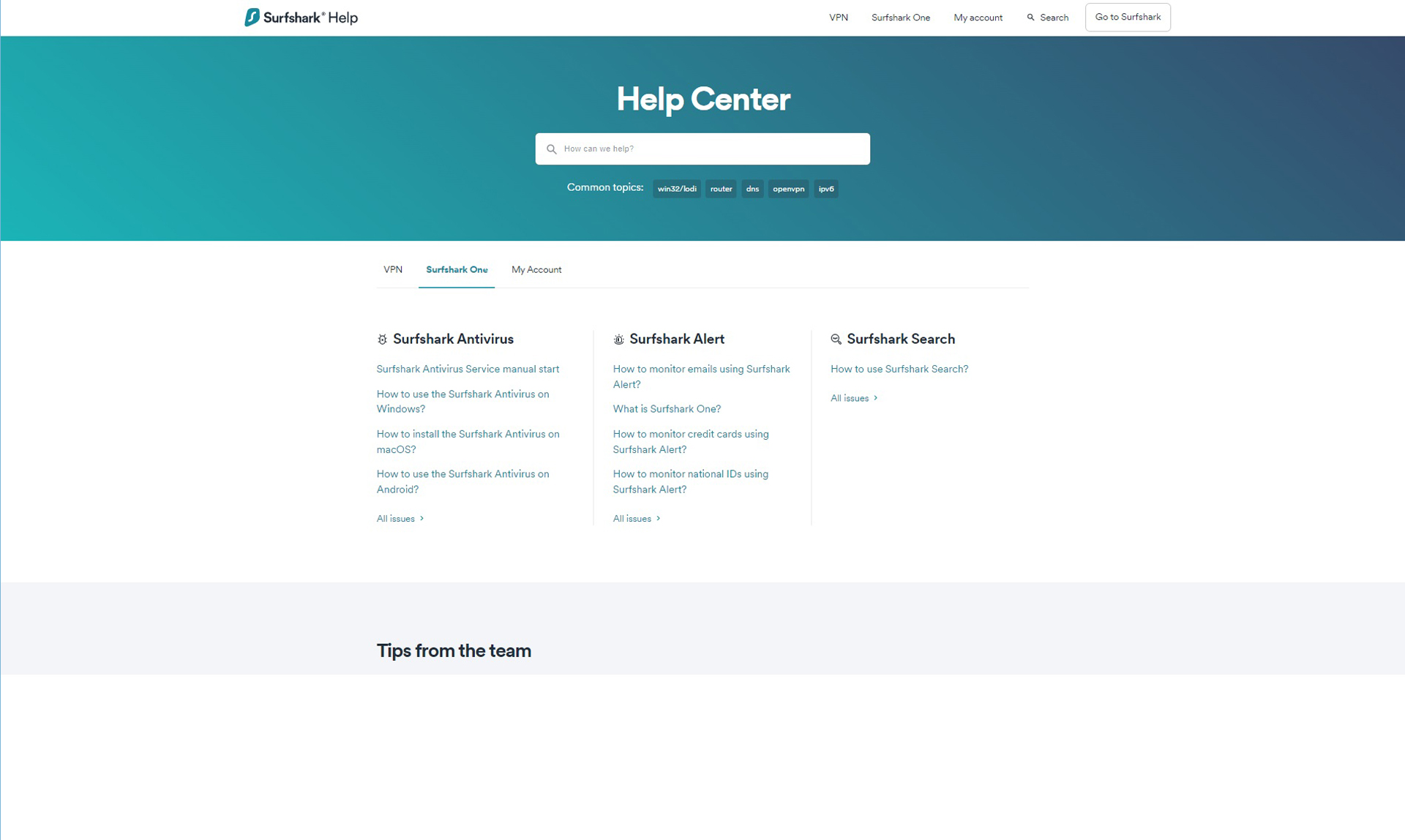
There are self-serve items to help with installation as well as tips for using the Alert and Search apps.
Surfshark One review: Verdict
Think of Surshark One as the mouse that roared of the security software world. It may not have the users that Bitdefender or Norton LifeLock do, but it offers a low price and an unlimited VPN. With just one product, Surfshark One is easy to shop for. Fast to scan and easy to load, its interface is a quick study, but with few things to adjust, which some will love while others will hate.
The program itself has low overhead but Surfshark One cuts into performance potential while scanning for threats. However, it has one of the fastest scanners but lacks the ability to examine a file directly from Windows Explorer.
Using malware detection and protection from Avira, Surfshark One provides very good protection against the worst that the web can throw at you while adding identity theft monitoring and a private search engine. It lacks many of the features that others have but this is by design. It all results in a simple, straight-forward program that does the basics — and more.
Brian Nadel is a freelance writer and editor who specializes in technology reporting and reviewing. He works out of the suburban New York City area and has covered topics from nuclear power plants and Wi-Fi routers to cars and tablets. The former editor-in-chief of Mobile Computing and Communications, Nadel is the recipient of the TransPacific Writing Award.
-
chrisichris Frustrating Experience with Surfshark - A Cautionary TaleReply
I’ve been a Surfshark customer for quite some time, but my experience with their service over the last few months has been nothing short of frustrating and exhausting. After dealing with endless issues and subpar support, I feel it’s only fair to share my experience so that others can make an informed decision.
The Problems
I initially encountered serious issues with Surfshark’s version 5.13, which simply didn’t work properly. Rather than providing a real solution, the support team suggested I roll back to an older, less secure version, which obviously wasn’t a feasible option. And when version 5.14 was released, there were no guarantees that it would work smoothly either. This lack of reliability left me in the dark and without proper protection for my devices. As a user who’s been comfortable with VPNs for years, I expected better. Instead, the issues with Surfshark went far beyond just software bugs. The app had such a significant impact on my system’s configuration that I had to fully reinstall Windows twice, losing hours of my time in the process. After the system crash caused by the software, I found that I couldn’t even log in to my PC properly, rendering it unusable.
2. Port 443 Miscommunication
Another issue arose around port 443. Initially, Surfshark’s support team claimed that my port was closed, which would have been a security issue. However, after conducting tests and providing photo evidence, I proved that the port was actually open. The support team’s initial miscommunication and failure to acknowledge this only added to my frustration.
3. The Toll on My Health
Beyond the technical problems, this entire ordeal has had a significant impact on my health. I suffer from anxiety and panic attacks, and the constant stress of trying to get this issue resolved has caused me to lose sleep and even feel physically ill at times. The level of support - or rather, the lack of it - has only made things worse. In the end, I decided to part ways with Surfshark. Despite having paid £70.96 for two years of service, I feel like I’ve received far less than I paid for, especially given the extensive downtime and constant problems. I reached out to Surfshark asking for a partial refund for the 18 months that I couldn’t use the service properly. Unfortunately, they flatly refused to even consider it. This lack of accountability speaks volumes about their disregard for customer satisfaction.
